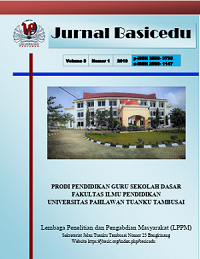Studi Komparatif antara Audio Dialog dan Monolog pada Pemahaman Keterampilan Mendengarkan Siswa
DOI:
https://doi.org/10.31004/basicedu.v8i4.8371Keywords:
Monolog, Dialog, Audio, ListeningAbstract
Dalam mengatasi kesulitan yang dialami siswa, guru dapat menggunakan teknologi untuk mendukung proses pembelajaran salah satunya dengan menggunakan audio dalam pembelajaran Bahasa Inggris. Penelitian ini bertujuan untuk menganalisis audio dialog dan monolog sebagai media pembelajaran yang dikategorikan sebagai studi komparatif dengan menggunakan metode deskriptif kuantitaif yaitu membandingan audio mana yang lebih efektif diantara keduanya. Hasil penelitian menunjukkan bahwa antara tes mendengarkan audio dialog dan monolog mempunyai hasil uji hipotesis yang berbeda, nilai t-tes sebesar 3,64 dan t-tabel untuk n = 48 pada taraf signifikan ? = 0,05 adalah 2,01. Karena t-tes > t-tabel (3,64 > 2,00), hal ini menunjukan terdapat perbedaan yang signifikan antara pemahaman menyimak siswa yang menggunakan dialog dan monolog. Oleh karena itu, dapat disimpulkan bahwa guru dapat menggunakan audio dialog sebagai media pembelajaran dalam pengajaran bahasa Inggris, khususnya dalam pemahaman mendengarkan karena terbukti bahwa hal ini dapat meningkatkan kemampuan mendengarkan bahasa Inggris siswa.
References
Amrullah, U. K. (2014). Teaching Speaking Skill through Listening Daily Conversation to The Eleventh Year Students of SMA PMDS Putri Palopo [PhD Thesis, Institut Agama Islam Negeri Palopo]. http://repository.iainpalopo.ac.id/id/eprint/2837/1/Ummu%20Klasum%20Amrullah.pdf
Anitah, S. (2012). Media Pembelajaran. Yuma Pustaka.
Arsyad, A. (2011). Media pembelajaran. Jakarta: PT Raja grafindo persada. https://www.academia.edu/download/30484693/jiptiain--umarhadini-8584-5-baii.pdf
Chen, T.-L., Sun, S.-J., Yang, X.-Z., & Luo, L. (2017). A Comparative Study of the Effects of Text and Speech Media on Memory Retention. 2nd International Conference on Education and Development. https://scholar.archive.org/work/kjndvl33kbcj5ia7addd6eh4um/access/wayback/http://dpi-proceedings.com/index.php/dtssehs/article/download/15139/20089
Curtis, A. M., Dennis, A. R., & McNamara, K. O. (2017). From Monologue to Dialogue. MIS Quarterly, 41(2), 559–582.
Daryanto, T. (2012). Konsep pembelajaran kreatif. Gava Media. https://balaiyanpus.jogjaprov.go.id/opac/detail-opac?id=10210
Drew, C. (2017). Edutaining audio: An exploration of education podcast design possibilities. Educational Media International, 54(1), 48–62. https://doi.org/10.1080/09523987.2017.1324360
Fox Tree, J. E. (1999). Listening in on monologues and dialogues. Discourse Processes, 27(1), 35–53. https://doi.org/10.1080/01638539909545049
Frobenius, M. (2014). The pragmatics of monologue: Interaction in video blogs. https://publikationen.sulb.uni-saarland.de/handle/20.500.11880/23695
Goh, C. C., & Vandergrift, L. (2021). Teaching and learning second language listening: Metacognition in action. Routledge. https://www.taylorfrancis.com/books/mono/10.4324/9780429287749/teaching-learning-second-language-listening-christine-goh-larry-vandergrift
Indriastuti, F. (2014). Peran Media Audio dalam Implementasi Kurikulum 2013 Melalui Pembelajaran Tema Terpadu di Sekolah Dasar. Jurnal Kwangsan, 2(2), 92–107.
Kamarullah, K., Muslem, A., & Manan, A. (2018). Applying English video learning materials in teaching listening. English Education Journal, 9(4), 527–539.
Karlina, N., & Setiyadi, R. (2019). The use of audio-visual learning media in improving student concentration in energy materials. PrimaryEdu: Journal of Primary Education, 3(1), 17–26.
Karpovich, I., Sheredekina, O., Krepkaia, T., & Voronova, L. (2021). The use of monologue speaking tasks to improve first-year students’ English-speaking skills. Education Sciences, 11(6), 298.
Lems, K. (2018). New Ideas for Teaching English Using Songs and Music. English Teaching Forum, 56(1), 14–21. https://eric.ed.gov/?id=EJ1181080
Long, M. H., & Doughty, C. J. (Eds.). (2009). The Handbook of Language Teaching (1st ed.). Wiley. https://doi.org/10.1002/9781444315783
Lynch, T., & Mendelsohn, D. (2013). Listening. In An introduction to applied linguistics (pp. 190–206). Routledge. https://www.taylorfrancis.com/chapters/edit/10.4324/9780203783733-16/listening-tony-lynch-david-mendelsohn
Marlena, N., Dwijayanti, R., & Widayati, I. (2019). Is audio visual media effective for learning? 1st International Conference on Education Social Sciences and Humanities (ICESSHum 2019), 260–264. https://www.atlantis-press.com/proceedings/icesshum-19/125914651
Maulina, M., Ignacio, J. F., Bersabe, L. A. C., Serrano, A. J. D., Carpio, N. G., & Santos, E. G. D. (2022). Technology-based media used in teaching listening skills. Exposure Jurnal Pendidikan Bahasa Dan Sastra Inggris, 11, 85–99.
Mohamadkhani, K., Farokhi, E. N., & Farokhi, H. N. (2013). The effect of using audio files on improving listening comprehension. International Journal of Learning and Development, 3(1), 132–137.
Munandar, I., & Tambunan, A. S. (2018). Audio Visual di Platform Digital: Studi Pada Youtube, Netflix, dan Spotify. Balai Pendidikan Dan Pelatihan Tambang Bawah Tanah, 17(32), 5–6.
Rahayuningsih, R., Rosalinah, Y., & Subroto, I. (2021). Teaching Listening Through Podcast. Wanastra: Jurnal Bahasa Dan Sastra, 13(2), 93–101.
Rahmatian, R., & Armiun, N. (2011). The effectiveness of audio and video documents in developing listening comprehension skill in a foreign language. International Journal of English Linguistics, 1(1), 115.
Tarmawan, I., Rusdiyana, R., Salim, A. D., & Ulpah, A. P. (2021). The role of podcasts as an alternative media for learning and distribution of audio based content. International Journal of Research and Applied Technology (INJURATECH), 1(1), 1–8.
Tyagi, B. (2013). Listening: An important skill and its various aspects. The Criterion An International Journal in English, 12(1), 1–8.
Winarto, W., Syahid, A., & Saguni, F. (2020). Effectiveness the use of audio visual media in teaching islamic religious education. International Journal of Contemporary Islamic Education, 2(1), 81–107.
Yahmun, Y., Sumarti, E., & Setyowati, D. (2020). Listening difficulties faced by the first semester students at basic listening class. Journey: Journal of English Language and Pedagogy, 3(1), 57–61.
Zhdanov, D. O., & Baklanov, P. A. (2020). Training English listening using e-learning resources. Arpha Proceedings, 3, 2895–2908.
Downloads
Published
How to Cite
Issue
Section
Citation Check
License
Copyright (c) 2024 Eva Meidi Kulsum, Ayang Winda Sri Widianingsih, Al-Fikri Hidayatullah, Rina Mutiarawati

This work is licensed under a Creative Commons Attribution-ShareAlike 4.0 International License.
Authors who publish with this journal agree to the following terms:
- Authors retain copyright and grant the journal right of first publication with the work simultaneously licensed under a Creative Commons Attribution License that allows others to share the work with an acknowledgement of the work’s authorship and initial publication in this journal.
- Authors are able to enter into separate, additional contractual arrangements for the non-exclusive distribution of the journal’s published version of the work (e.g., post it to an institutional repository or publish it in a book), with an acknowledgement of its initial publication in this journal.
- Authors are permitted and encouraged to post their work online (e.g., in institutional repositories or on their website) prior to and during the submission process, as it can lead to productive exchanges, as well as earlier and greater citation of published work (See The Effect of Open Access).



